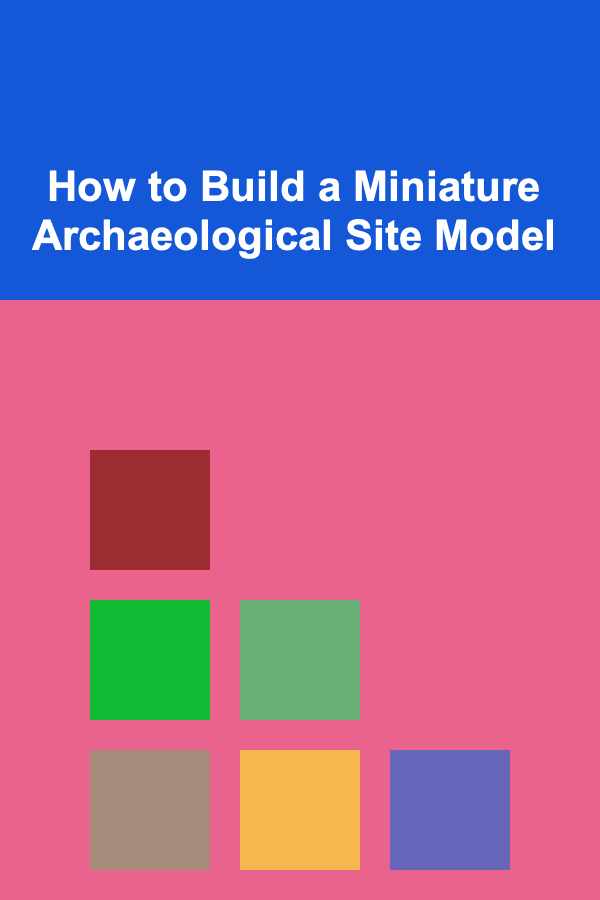
How to Build a Miniature Archaeological Site Model
ebook include PDF & Audio bundle (Micro Guide)
$12.99$10.99
Limited Time Offer! Order within the next:

Creating a miniature archaeological site model is a fascinating and rewarding project that blends art, science, and history. Whether for educational purposes, museum displays, research visualization, or personal enjoyment, building a detailed and accurate archaeological model requires careful planning, research, and craftsmanship. This guide explores the entire process---from conceptualization and research to construction, detailing, and presentation---providing deep insight into how to build a miniature archaeological site model that is both realistic and informative.
Understanding the Purpose and Scope
Before beginning any model-building project, it is essential to define the purpose of your miniature archaeological site model. The goals will influence every step---from the scale you choose to the level of detail and the materials used.
Educational Display
If the model is intended for an educational setting, such as a classroom or museum exhibit, accuracy and clarity are paramount. You want to represent the site in a way that highlights its archaeological features, stratigraphy, and cultural artifacts clearly for learning.
Research Visualization
Archaeologists sometimes build scale models to visualize spatial relationships of structures, artifact distributions, and landscape features. For this use, precision is essential to communicate hypotheses about the site's layout and usage.
Artistic or Hobbyist Project
For hobbyists or artistic endeavors, the focus might be more on aesthetic appeal and creative expression rather than scientific precision, though accuracy is still valued.
Scope Considerations
- Site Size: Will the model represent an entire archaeological site, a single structure, or a specific excavation area?
- Time Period: Are you modeling the site as it currently stands, at a particular historical moment, or at various phases of occupation?
- Level of Detail: How much detail will be included? Just major structures? Soil layers? Small artifacts?
Step 1: Comprehensive Research and Documentation
Building a miniature archaeological site model starts with thorough research. The more you understand the site, the more accurate and meaningful your model will be.
Collecting Site Data
- Site Maps and Plans: Obtain existing archaeological site plans, topographic maps, or GIS data that outline the structures and features.
- Photographs and Drawings: Use photographs, sketches, and aerial imagery to understand the site's layout and details.
- Excavation Reports: Study archaeological reports for stratigraphy, artifact distribution, and interpretations.
- Academic Papers and Books: Review scholarly publications related to the site for contextual information.
- Consult Experts: If possible, consult archaeologists or site managers for firsthand insights.
Understanding Archaeological Context
- Stratigraphy: Understand the soil layers and how they relate to the site's occupation phases.
- Architecture: Study the building techniques, materials, and styles represented in the site's remains.
- Artifacts: Consider whether and how artifacts should be represented.
- Landscape Features: Include natural features such as rivers, hills, and vegetation that affect site interpretation.
Creating a Site Blueprint
Using the gathered information, create a detailed blueprint or sketch of the site to guide your model's construction. Include:
- Scale measurements for every feature.
- Locations of structures, excavation trenches, and natural elements.
- Vertical sections if you plan to represent stratigraphy.
Step 2: Choosing the Scale and Materials
Deciding on the Scale
Scale selection is crucial because it affects the model's size, detail level, and the materials you can use.
- Common Scales: Archaeological models often use 1:50, 1:100, or 1:200 scales. Smaller scales allow you to represent larger sites but limit detail; larger scales permit intricate detail but take more space.
- Practical Considerations: Choose a scale that fits your workspace and budget while allowing for the desired detail.
Selecting Materials
The choice of materials depends on scale, durability, budget, and desired realism.
Base and Terrain Materials
- Foam Boards and Styrofoam: Lightweight and easy to carve for creating terrain elevation.
- Plaster and Clay: Useful for texturing terrain and modeling soil layers.
- Wood and MDF Boards: Provide a sturdy base for the entire model.
Structural Materials
- Cardboard and Foam Core: Useful for walls, foundations, and structural outlines.
- Balsa Wood and Basswood: Great for detailed architectural elements due to ease of cutting and shaping.
- 3D Printed Components: Increasingly popular for detailed or intricate structures.
Surface Textures and Details
- Sand, Gravel, and Model Railroad Ballast: For representing soil, pathways, or rubble.
- Static Grass, Flock, and Model Trees: To simulate vegetation.
- Paints and Pigments: Acrylics and weathering powders to add color and realism.
Adhesives and Tools
- PVA Glue and Super Glue: Common for bonding various materials.
- Cutting Tools: Precision knives, saws, and files.
- Modeling Tools: Sculpting tools, brushes, and airbrushes.
Step 3: Constructing the Base and Terrain
Start by creating a stable base for your model. This will support the entire structure and define the overall footprint.
Preparing the Base
- Use a wooden or MDF board for rigidity.
- Mark the site boundaries according to your scale blueprint.
- Decide if the model will be enclosed in a case or open.
Modeling Terrain Elevation
- Use layers of foam or carved Styrofoam to represent hills, trenches, and other elevation changes.
- Layer plaster or clay over foam to smooth surfaces and add texture.
- Carve trenches or excavation pits carefully, referencing site plans.
Representing Stratigraphy
If your model aims to show soil layers or excavation phases, consider a vertical cross-section approach:
- Build up soil layers with colored clays or layered plaster.
- Use transparent sides (e.g., acrylic panels) for cross-section viewing.
- Clearly differentiate layers using color, texture, and thickness.
Step 4: Building Structures and Features
Foundations and Walls
- Use balsa wood, foam core, or cardboard to build foundations and walls.
- Cut pieces precisely according to scaled measurements.
- Texture walls to mimic stone, brick, or adobe using sculpting tools or textured paints.
Architectural Details
- Add windows, doorways, and roof elements carefully, scaled appropriately.
- For stonework or bricks, consider embossing or painting techniques.
- Use 3D printing or laser-cut parts for intricate elements if available.
Recreating Excavation Context
- If modeling an active dig, depict excavation tools, grid markers, and partially uncovered features.
- Include replica artifacts or broken pottery shards scaled down.
- Represent trenches with accurate depth and profile.
Natural Features
- Add rivers, ponds, or wells using resin or gloss varnish.
- Use model vegetation to replicate site flora.
- Incorporate pathways, roads, or fences where appropriate.
Step 5: Painting and Weathering
Painting is crucial for transforming raw materials into a convincing miniature environment.
Base Painting
- Start with an appropriate base color for soil, stone, or building materials.
- Use acrylic paints for fast drying and layering.
Adding Texture and Depth
- Dry brushing techniques can highlight surface details like stonework or wood grain.
- Use washes (diluted paint) to accentuate cracks, crevices, and shadows.
- Apply pigments or chalk pastels to add weathering effects like dirt, moss, or erosion.
Vegetation Coloring
- Paint model vegetation in varied greens, browns, and yellows to mimic natural variations.
- Consider seasonal changes if your model depicts a specific time of year.
Step 6: Adding Small Details and Artifacts
Details bring your model to life, making it both visually engaging and educational.
Miniature Artifacts
- Use tiny replica pottery shards, tools, or bones placed within excavation areas.
- Replicate ancient features such as hearths, postholes, or storage pits.
Human Figures and Tools
- Add scaled figures of archaeologists working, which adds narrative and scale reference.
- Place miniature tools such as brushes, trowels, and buckets to simulate ongoing excavation.
Signage and Labels
- Include small signs explaining parts of the site or excavation areas.
- Use labels or legend cards for educational purposes.
Step 7: Presentation and Protection
Display Case
- Protect your model from dust and damage by placing it in a clear acrylic or glass display case.
- Ensure the case allows viewers to see all angles without obstruction.
Lighting
- Use LED lights to highlight key features.
- Consider adjustable lighting to create shadows and enhance depth perception.
Accessibility
- Make sure the model is accessible for viewing at appropriate height.
- Provide explanatory materials or digital supplements if for educational purposes.
Step 8: Maintenance and Updating
Archaeological interpretations evolve, and models may need updating.
- Keep your blueprint and notes for future reference.
- Plan for modular components that can be swapped or updated.
- Regularly clean and inspect the model to maintain its condition.
Additional Tips and Considerations
Time Management
Building a detailed archaeological model is time-consuming. Plan phases and allow time for materials to dry or set.
Budgeting
Materials and tools can add up. Prioritize key features and use economical alternatives when possible.
Collaboration
If possible, work with archaeologists, artists, or educators to enrich your model's accuracy and appeal.
Learning Through Building
Use the model-building process as a learning opportunity---deepening your knowledge about archaeological methods, site history, and cultural significance.
Conclusion
Building a miniature archaeological site model is a multidisciplinary endeavor combining research, craftsmanship, and creativity. By thoroughly understanding your site, carefully planning, choosing appropriate scales and materials, and paying attention to detail in construction and presentation, you can create a model that not only looks impressive but also educates and inspires.
This process deepens appreciation for archaeology, helps visualize the past, and brings ancient sites closer to people's understanding. Whether for professional, educational, or personal purposes, your miniature archaeological model will stand as a tangible link to history, bridging the gap between the past and present.
If you'd like, I can help you with specific techniques or materials for parts of your model!
Reading More From Our Other Websites
- [Home Cleaning 101] How to Organize and Clean Your Spice Rack: A Comprehensive Guide
- [Home Party Planning 101] How to Find the Right Hen Party Organisers for Your Style
- [Screen Printing Tip 101] How to Set Up a Portable Outdoor Screen‑Printing Booth for Event Merchandising
- [Home Budget 101] How to Create a Home Budget That Accommodates Your Lifestyle
- [Home Budget 101] How to Set Financial Goals for Your Family
- [Home Lighting 101] How to Optimize Task Lighting for Productivity in Your Home
- [Home Staging 101] How to Implement Smart Home Staging for Different Budgets on a Shoestring
- [Organization Tip 101] What Are the Essentials for an Organized Home Office Desk?
- [Organization Tip 101] How to Use Clear Storage Bins for Shoe Organization
- [Personal Finance Management 101] How to Pay Yourself First: The Secret to Building Wealth

How to Design a Functional Laundry Room with Storage Solutions
Read More
How to Troubleshoot and Fix Common Plumbing Problems in Your Home
Read More
How to Use Binders to Keep Information Organized
Read More
How to Use Dropshipping Suppliers to Manage Returns and Refunds: An Actionable Guide
Read More
How to Handle Backtalk and Disrespect: A Comprehensive Guide
Read More
How to Repair Vintage Gun Stocks
Read MoreOther Products

How to Design a Functional Laundry Room with Storage Solutions
Read More
How to Troubleshoot and Fix Common Plumbing Problems in Your Home
Read More
How to Use Binders to Keep Information Organized
Read More
How to Use Dropshipping Suppliers to Manage Returns and Refunds: An Actionable Guide
Read More
How to Handle Backtalk and Disrespect: A Comprehensive Guide
Read More